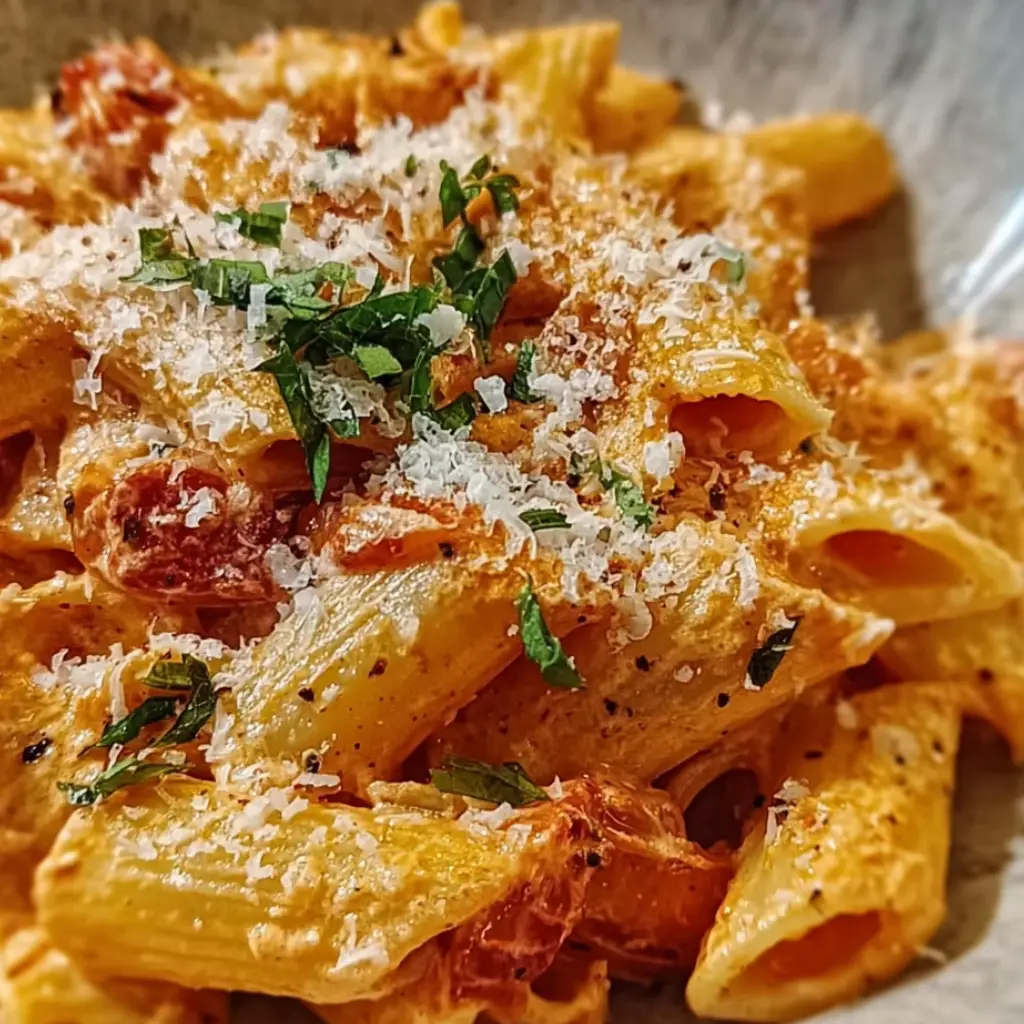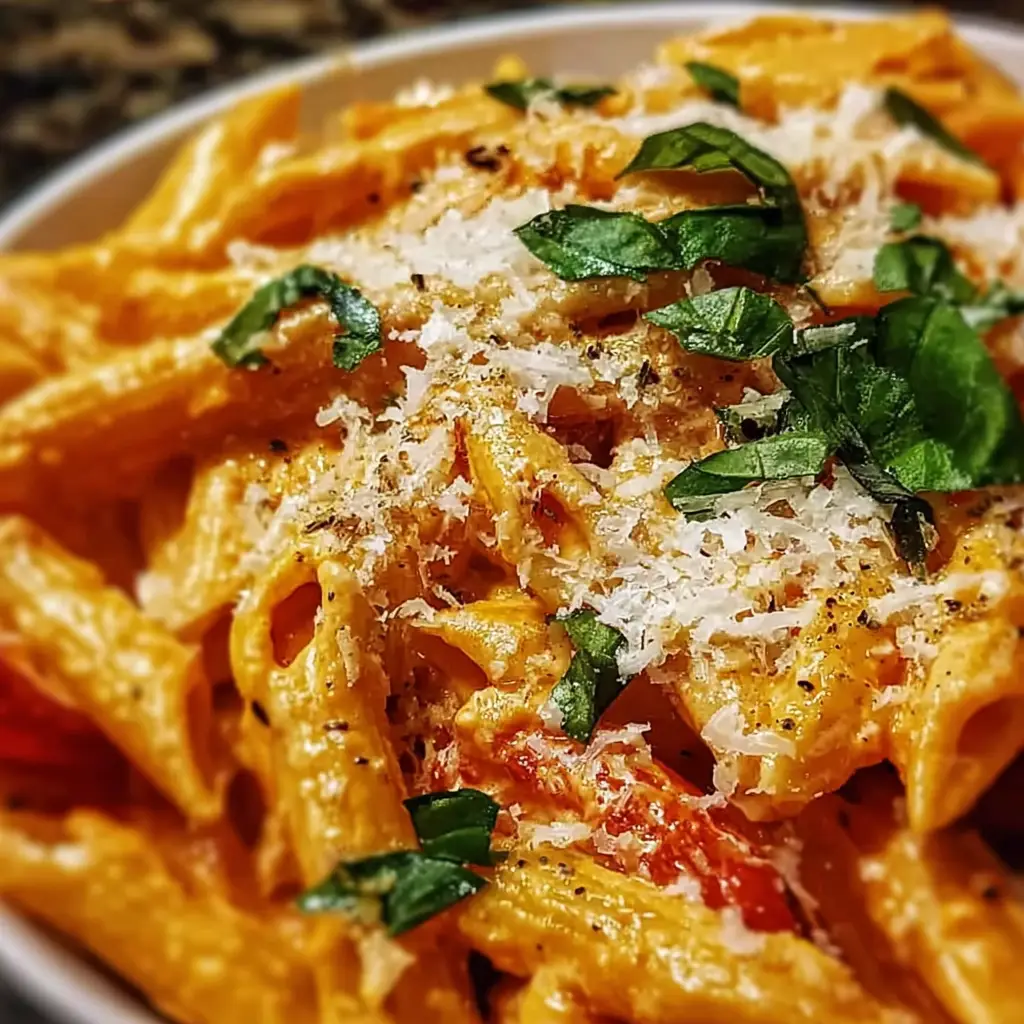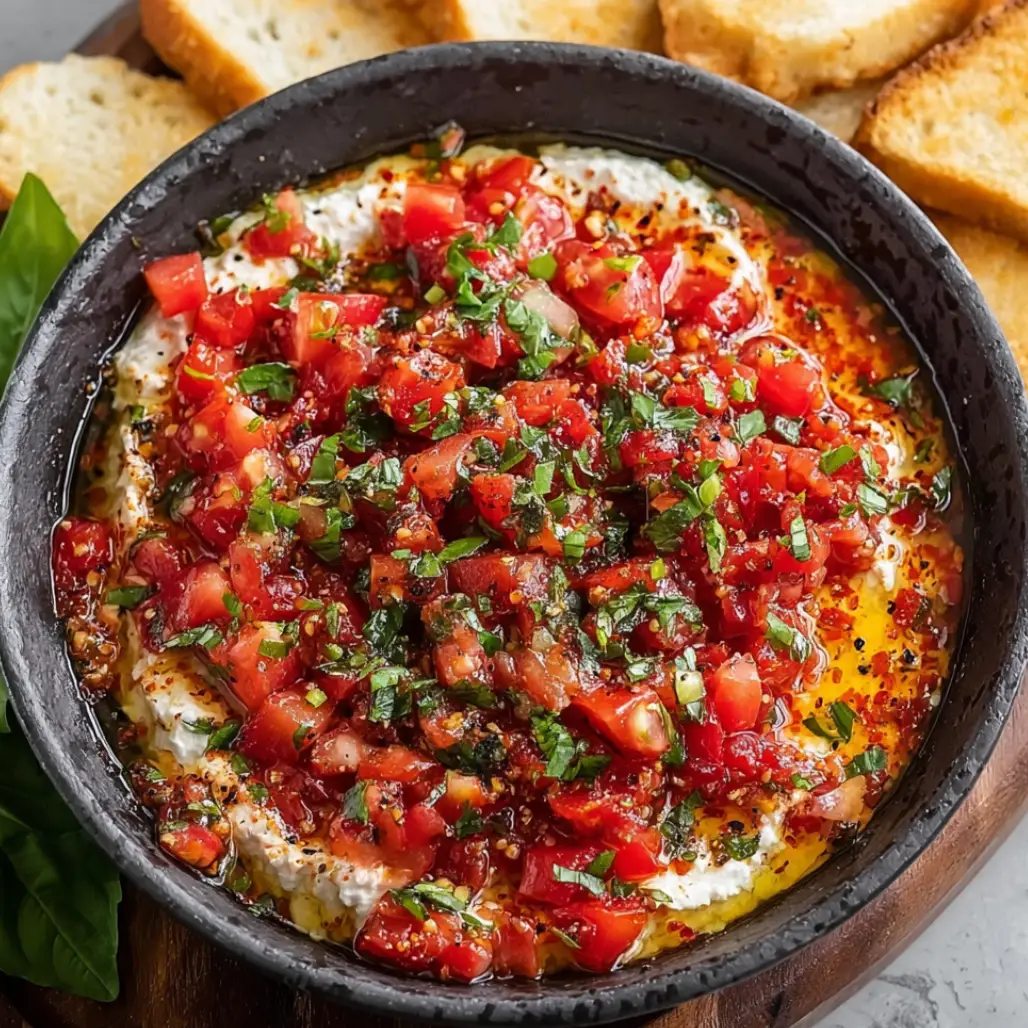| Prep Time: 10 minutes | Cook Time: 25 minutes | Total Time: 35 minutes | Serves: 6 |
|---|
When weeknight dinners demand something spectacular yet achievable, creamy tomato ricotta pasta delivers the perfect harmony of comfort and sophistication because it transforms humble ingredients into a restaurant-quality meal that satisfies both the soul and the palate. This indulgent yet surprisingly light dish showcases the magical combination of rich ricotta cheese with vibrant tomatoes, creating a luxurious sauce that clings beautifully to every strand of pasta because the natural creaminess of ricotta eliminates the need for heavy cream while adding protein and depth to each satisfying bite.
Why This Creamy Tomato Ricotta Pasta Recipe Works
The brilliance of this creamy tomato ricotta pasta lies in its elegant simplicity because it relies on the natural sweetness of tomatoes enhanced by the mild tang of fresh ricotta to create complex flavors without overwhelming techniques or exotic ingredients. Unlike traditional cream-based sauces that can feel heavy and mask delicate flavors, ricotta provides a lighter yet equally satisfying richness because its protein structure creates a naturally smooth texture when properly incorporated with pasta water and gentle heat.
This technique produces superior results compared to conventional creamy pasta preparations because ricotta maintains its integrity throughout the cooking process while developing a silky consistency that coats pasta beautifully. The key lies in understanding how ricotta responds to heat and moisture, creating a sauce that feels indulgent without the digestive heaviness often associated with cream-laden dishes because the cheese’s natural composition provides richness while maintaining a fresh, clean finish.
Essential Ingredients for Perfect Results
1 pound penne or rigatoni pasta (short shapes hold the sauce beautifully)
2 pounds fresh ripe tomatoes (Roma or vine tomatoes work best for sweetness)
15 ounces whole milk ricotta cheese (room temperature for smooth blending)
1/2 cup freshly grated Parmesan cheese (plus extra for serving)
4 cloves fresh garlic (minced finely for even distribution)
1 medium yellow onion (diced for aromatic base)
1/4 cup extra virgin olive oil (high quality for best flavor)
1/2 cup dry white wine (optional, for depth and acidity)
1/4 cup fresh basil leaves (torn by hand for maximum fragrance)
2 tablespoons fresh thyme leaves (or 1 tablespoon dried)
1 teaspoon sea salt (adjust to taste preference)
1/2 teaspoon freshly ground black pepper (for subtle warmth)
1/4 teaspoon red pepper flakes (optional, for gentle heat)
2 tablespoons unsalted butter (for finishing richness)
The Art of Creating Exceptional Creamy Tomato Ricotta Pasta
Creating exceptional creamy tomato ricotta pasta requires understanding the delicate balance between acidity and richness because tomatoes provide bright acidity that must be harmonized with the mellow creaminess of ricotta to achieve the perfect flavor profile. The technique involves building layers of flavor through proper ingredient preparation and timing, ensuring each component contributes to the final dish’s complexity while maintaining the overall harmony that makes this pasta so memorable.
Success depends on respecting the natural characteristics of each ingredient because fresh tomatoes need time to break down and concentrate their flavors, while ricotta requires gentle treatment to prevent curdling or graininess. The pasta cooking water becomes crucial in this recipe because its starch content helps bind the ricotta into a smooth, cohesive sauce that clings to the pasta without separating or becoming watery during the final assembly process.
Step-by-Step Instructions for Perfect Results
Begin by bringing a large pot of salted water to a rolling boil because properly salted pasta water seasons the pasta from within while providing the starchy liquid needed to create the perfect sauce consistency. Add the pasta and cook according to package directions until al dente, remembering to reserve one cup of the pasta cooking water before draining because this starchy liquid will be essential for achieving the ideal sauce texture.
Professional Tip: Salt your pasta water generously until it tastes like seawater because this is your only opportunity to season the pasta itself from the inside out.
Step 1: Proper pasta cooking creates the foundation for sauce adhesion and overall dish success, so timing becomes crucial for optimal results.
While the pasta cooks, prepare the tomatoes by scoring an X on the bottom of each one and blanching them in boiling water for 60 seconds before transferring to an ice bath because this technique makes peeling effortless while preserving the tomato’s structure. Remove the skins and roughly chop the tomatoes, discarding the seeds to prevent excess liquid in the final sauce.
Professional Tip: Removing tomato seeds prevents the sauce from becoming watery while concentrating the tomato flavor for maximum impact.
Step 2: Proper tomato preparation ensures optimal texture and prevents dilution of the final sauce consistency.
Heat the olive oil in a large, heavy-bottomed skillet over medium heat, then add the diced onion and cook until translucent and fragrant, approximately 8-10 minutes because patient cooking develops the onion’s natural sweetness without browning. Add the minced garlic and cook for an additional 30 seconds until aromatic, being careful not to let it brown because burnt garlic creates bitter flavors that will overpower the delicate sauce.
Professional Tip: Keep the heat at medium to prevent the garlic from burning while allowing the onions to develop their full flavor potential.
Step 3: Building the aromatic base properly ensures balanced flavor development throughout the entire cooking process.
Add the chopped tomatoes to the skillet along with the thyme, salt, pepper, and red pepper flakes, stirring to combine all ingredients evenly because proper distribution ensures consistent seasoning throughout the sauce. Cook the mixture for 15-20 minutes, stirring occasionally, until the tomatoes break down completely and the sauce reduces to a thick, concentrated consistency that coats the back of a spoon.
Professional Tip: Allow the sauce to reduce properly because concentrated flavors create more impact than watery sauces that lack depth and richness.
Step 4: Patience during the reduction process develops complex flavors and creates the proper consistency for sauce success.
If using wine, add it to the tomato mixture and cook for 2-3 minutes to allow the alcohol to evaporate while the wine’s acidity brightens the overall flavor profile because properly reduced wine adds complexity without overwhelming the delicate balance of ingredients. The sauce should smell fragrant and rich without any harsh alcohol notes remaining.
Professional Tip: Choose a wine you would drink because cooking concentrates flavors, and poor-quality wine will negatively impact the final dish.
Step 5: Wine integration requires proper cooking time to develop flavor benefits while eliminating harsh alcohol notes.
In a separate bowl, gently break up the ricotta with a fork until smooth, then gradually whisk in 1/2 cup of the reserved pasta cooking water until the mixture reaches a creamy, pourable consistency because this technique prevents lumps and creates the smooth texture essential for professional-quality results. The mixture should be creamy but not thin, maintaining enough body to create a substantial sauce.
Professional Tip: Use pasta cooking water instead of plain water because the starch content helps bind the ricotta and create better sauce cohesion.
Step 6: Proper ricotta preparation prevents graininess and ensures smooth integration with the tomato base for optimal texture.
Remove the tomato sauce from heat and immediately stir in the prepared ricotta mixture, whisking constantly to prevent curdling because gentle incorporation maintains the sauce’s smooth texture while preventing separation. Add the cooked pasta directly to the sauce along with the butter and half of the Parmesan cheese, tossing vigorously to combine all ingredients thoroughly.
Professional Tip: Remove from heat before adding ricotta because excessive heat can cause the cheese to curdle and create an unpleasant texture.
Step 7: Gentle heat management during final assembly ensures creamy consistency without compromising the ricotta’s smooth texture.
Add additional pasta cooking water as needed to achieve the desired sauce consistency, remembering that the sauce will continue to thicken slightly as it cools because the starch content continues to develop even after cooking stops. Taste and adjust seasoning with salt and pepper, then garnish with torn fresh basil leaves and remaining Parmesan cheese before serving immediately.
Professional Tip: Serve immediately while the pasta is hot because creamy tomato ricotta pasta is best enjoyed fresh when the sauce maintains its optimal consistency.
Step 8: Final seasoning adjustments and immediate service ensure the best possible dining experience with optimal texture and temperature.
Professional Tips for Culinary Excellence
Quality ingredients make an extraordinary difference in creamy tomato ricotta pasta because the simplicity of the dish allows each component’s flavor to shine through without masking or compensation. Choose the ripest, most flavorful tomatoes available because their natural sweetness and acidity form the foundation of the entire dish, while high-quality ricotta provides the creamy richness that distinguishes this pasta from ordinary preparations.
Temperature control proves crucial throughout the cooking process because ricotta can curdle if exposed to excessive heat, while tomatoes need adequate cooking time to develop their full flavor potential. Monitor the sauce carefully during the final assembly, adding ricotta only after removing the pan from direct heat to ensure smooth, creamy results without any unpleasant texture issues.
Pasta shape selection impacts the final eating experience because short, tubular shapes like penne and rigatoni hold the creamy sauce better than long, thin pasta varieties. The ridges and hollow centers trap the ricotta mixture, ensuring each bite delivers the full flavor profile while providing satisfying texture contrast between the tender pasta and rich, creamy coating.
Creative Variations to Explore
Transform your creamy tomato ricotta pasta into a protein-rich meal by incorporating grilled chicken, sautéed shrimp, or Italian sausage because these additions complement the creamy sauce while providing substantial nutrition for hearty appetites. Consider adding roasted vegetables such as zucchini, bell peppers, or eggplant to create a more complex dish that showcases seasonal produce while maintaining the recipe’s essential character.
For those who enjoy bolder flavors, experiment with sun-dried tomatoes, roasted red peppers, or caramelized onions because these ingredients add concentrated flavors that enhance rather than compete with the ricotta base. Mediterranean variations might include olives, capers, and fresh oregano for a more rustic interpretation that celebrates the ingredient combinations traditional to Italian coastal cooking.
Create a lighter version by incorporating fresh spinach, arugula, or baby kale during the final cooking stage because these greens wilt quickly while adding color, nutrition, and subtle flavor complexity. The slight bitterness of greens provides excellent balance to the rich, creamy sauce while increasing the dish’s nutritional value without compromising its comfort food appeal.
Perfect Pairing Ideas for Complete Meals
Serve your creamy tomato ricotta pasta alongside crispy garlic bread or focaccia because the crunchy texture provides delightful contrast to the smooth, creamy pasta while offering opportunities to enjoy every drop of the delicious sauce. Consider exploring various savory sides that complement Italian flavors while adding nutritional balance to the meal.
Light, refreshing salads featuring mixed greens, cherry tomatoes, and balsamic vinaigrette provide excellent balance to the rich pasta because the acidity cuts through the creamy richness while cleansing the palate between bites. Browse through elegant salad options that pair beautifully with cream-based pasta dishes for inspiration.
For special occasions, begin the meal with sophisticated appetizers that complement Italian themes while preparing guests for the main course. Consider bruschetta, antipasto platters, or stuffed mushrooms that echo the Mediterranean flavors without overwhelming the palate before the creamy pasta course.
Discover More Culinary Adventures
Enhance your Italian dining experience with carefully selected dips and marinades that complement pasta-based meals while providing opportunities for interactive dining and flavor customization. These accompaniments allow guests to personalize their experience while exploring different taste combinations that enhance the overall meal.
Complete your pasta feast with thoughtfully chosen beverages that cleanse the palate and complement the rich, creamy flavors without competing with the main dish. The right beverage pairings can elevate the entire dining experience while providing refreshing contrast to the substantial pasta course.
Expand your repertoire with complementary side dishes that enhance Italian-themed meals while providing nutritional balance and visual appeal to create restaurant-quality presentations at home. Consider how different textures and flavors work together to create cohesive, memorable dining experiences.
Storage Guidelines for Food Safety
Store leftover creamy tomato ricotta pasta in airtight containers in the refrigerator for up to three days because proper storage prevents bacterial growth while maintaining flavor quality throughout the storage period. Always refrigerate within two hours of cooking to ensure food safety standards are maintained and the dish remains safe for consumption.
When reheating, add a splash of milk, cream, or pasta water to restore the original creamy consistency because refrigeration causes the sauce to thicken and lose its smooth texture. Heat gently over low heat, stirring frequently to prevent the ricotta from curdling or separating during the reheating process.
Avoid freezing creamy tomato ricotta pasta because dairy-based sauces typically separate and become grainy when frozen and thawed, resulting in unpleasant texture changes that cannot be corrected. Fresh preparation always yields superior results compared to frozen and reheated versions of this delicate dish.
The Science Behind Perfect Cream Sauce Creation
Ricotta cheese differs from other dairy products because its unique protein structure allows it to create creamy textures without the need for heavy cream or butter-based roux, making it an excellent choice for lighter yet satisfying sauces. The key lies in understanding how ricotta responds to heat and moisture, requiring gentle treatment to maintain its smooth consistency throughout the cooking process.
Pasta cooking water contains dissolved starches that act as natural emulsifiers, helping bind the ricotta into a smooth, cohesive sauce that clings beautifully to pasta shapes because these starches create molecular bonds that prevent separation. This scientific principle explains why pasta cooking water proves superior to plain water for achieving professional-quality sauce consistency.
Temperature control remains crucial because excessive heat causes ricotta proteins to contract and separate, creating grainy textures that cannot be corrected once they occur. Understanding this principle allows home cooks to achieve restaurant-quality results by managing heat carefully during the final assembly process.
Troubleshooting Common Issues
If your creamy tomato ricotta pasta turns out grainy, the most likely cause is excessive heat during the ricotta incorporation phase because high temperatures cause the cheese proteins to separate and create unpleasant texture. Prevent this issue by removing the pan from heat before adding ricotta and whisking gently but thoroughly to ensure smooth integration.
Watery sauce typically results from inadequate tomato reduction or using tomatoes with high water content because insufficient cooking time prevents proper flavor concentration. Allow extra cooking time for the tomato base to reduce properly, and consider removing excess liquid from fresh tomatoes before cooking to prevent dilution.
When the sauce separates or appears oily, the issue usually stems from temperature shock or insufficient emulsification because the ingredients haven’t been properly bound together. Add warm pasta cooking water gradually while whisking vigorously to re-emulsify the sauce and restore its smooth, creamy consistency.
Additional Inspirations for Pasta Lovers
Begin your Italian feast with creative breakfast favorites that set the stage for special occasion meals because thoughtful menu planning creates memorable dining experiences that guests will appreciate and remember. Consider how different courses work together to create cohesive themes throughout the meal.
Conclude your pasta dinner with elegant dessert options that provide the perfect finish to a satisfying meal because the right dessert can elevate the entire dining experience while leaving guests feeling completely satisfied. Choose desserts that complement rather than compete with the rich, savory flavors of the main course.
Explore complementary pasta techniques and flavor combinations that expand your culinary repertoire while building on the skills developed through mastering creamy tomato ricotta pasta because understanding fundamental principles allows for endless creativity and adaptation in the kitchen.
Conclusion
This creamy tomato ricotta pasta represents the perfect marriage of Italian tradition and modern convenience because it delivers sophisticated flavors through accessible techniques that home cooks can master with confidence and consistent success. The combination of fresh tomatoes, creamy ricotta, and aromatic herbs creates a dish that satisfies both comfort food cravings and fine dining aspirations while remaining approachable for weeknight family meals.
The versatility of this preparation method opens endless possibilities for customization and creativity because the basic technique can be adapted to accommodate seasonal ingredients, dietary preferences, and personal taste preferences without compromising the essential character that makes this pasta so appealing. Whether served as an elegant dinner party centerpiece or enjoyed as a comforting family meal, creamy tomato ricotta pasta provides the foundation for countless memorable dining experiences that bring people together around the table while celebrating the simple pleasure of expertly prepared comfort food.









